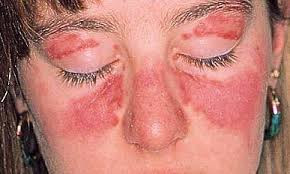Sunburn or sun poisoning is common after overexposure to sun.
Who doesn’t like a healthy tan?
But there is something called overdoing!
And overdoing the lying-on-the-beach with tons of suntan lotion might wreak havoc with your skin later by way of sun poisoning or sunburn.
According to a survey conducted by a Skin Cancer Foundation, 42% of the questioned people admitted getting a sunburn AT LEAST once a year.
Sunburns
Sunburns
The problem is more common among children (with almost 70% of them getting a sunburn every year) , probably because their skin is more sensitive than adults.
Causes of Sunburn or Sun Poisoning
What, then, are the causes of sunburn?
Though you can get a sunburn at any time of the year, they are most common during the summer months when the sun shines mercilessly on you. This is because the sun rays are strongest at this time of the year.
Strictly speaking, sunburn means: burns on the skin due to exposure to ultraviolet radiation present in sun rays.
Too much exposure to the sun (and, thereby, the ultraviolet rays or UV rays) causes inflammation along the skin (blisters from sunburn) which can start appearing within 30 minutes of sun exposure.
Types of UV radiations
The UV rays emitted by the sun are of three different wavelengths:
UV A
UV B, and
UV C.
Out of these three, UV C rays do not reach the surface of the Earth.
The other two types of radiations- UV A and UV B do reach the Earth and are capable of penetrating the skin causing deep underlying damage to it. Though our body needs limited exposure to UV rays to produce Vitamin D needed by us, too much of this exposure can have serious implications.
Sunburn indicates that a person has been exposed to UV rays for too long. And sunburn or sun poisoning is not the only form of damage that can be caused by these UV rays.
The damage caused by UV A and UV B rays is not always visible. Since UV rays can penetrate beneath the surface of the skin, they can alter the DNA and cause photoaging (premature aging of skinand appearance of fine wrinkles).
Photoaging
Photoaging
If the DNA damage goes on unchecked, it can even cause melanoma or skin cancer.
The UV B rays, in particular, are capable of inflicting more serious damage.
Risk Factors for Sunburn
The degree of sunburns or the severity of the burns a person will get will depend upon a number of factors. The following are the risk factors for sunburn
Skin type- People with lighter hair and fairer skin get a sunburn faster than their counterparts with darker skin and hair.
The intensity of the sun- People staying in regions close to the equator are more likely to get a sunburn as compared to those who stay farther from it because the sunrays fall more intensely over the equator.
Duration of exposure to the sun- Obviously, the longer the duration of exposure to sun, the greater will be the chances of sun poisoning.
Medications- Medicines like diuretics (water pills), oral contraceptives and certain antibiotics can also increase the sensitivity of the skin to sun, making it more highly vulnerable.
“A blonde-haired, blue-eyed woman sunbathing in Rio de Janeiro will redden far sooner than an olive-complexioned woman sitting out on a sunny day in New York City”, it has been observed.
We have talked at length about the causes of sunburn or sun poisoning and the risk factors for sunburn in this post. Keep reading, since the next post will be about the symptoms of sunburn.
Home
»
diet
»
fit
»
fitness tips
»
fitness tips for women
»
health
»
lose weight tips
»
running
»
workout
»
yoga
» Causes of Sunburn or Sun Poisoning
Subscribe to:
Post Comments (Atom)

Post a Comment
Note: only a member of this blog may post a comment.